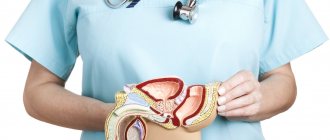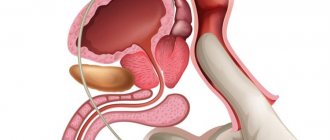Published: 06/22/2021 11:30:00 Updated: 06/22/2021
Prostatitis is an inflammation of the prostate gland, one of the common problems in 40% of middle-aged and older men [5]. Without directly threatening life, this disease leads to a significant decrease in its quality, affecting performance, the intimate sphere, limiting freedom and provoking everyday difficulties and psychological disorders.
Prostatitis occurs in acute or chronic form and can be of infectious or non-infectious origin.
Causes of prostatitis
The causes of prostatitis are varied: the acute form is associated with a bacterial infection that enters the prostate gland through the ascending route during urological and venereal diseases of an infectious nature, chronic prostatitis in 90% of cases is not associated with infections [2, 3, 5, 6]. Stagnation of prostate secretion is formed both as a result of infectious inflammation of the duct walls and systemic diseases [5].
Causes of acute prostatitis
Acute bacterial prostatitis is caused by enterobacteria, Gram-negative and Gram-positive cocci [5], chlamydia, mycoplasma [4], and viruses [2, 3].
Risk factors for prostate infection are sexually transmitted diseases and invasive urological interventions (catheterization, instillation and diversion of the urethra, urocystoscopy) [6]. Provocateurs for the development of infectious inflammation are usually hypothermia, prolonged constipation or diarrhea, sedentary work, excessive sexual activity or sexual abstinence, chronic sexually transmitted and urological diseases, suppressed immune response, lack of sleep, overtraining, chronic stress. By worsening the blood supply to the pelvic organs, these factors themselves contribute to aseptic inflammation and also facilitate the introduction of the pathogen into the prostate tissue [6].
Acute bacterial inflammation can resolve without consequences, but in some cases the following complications develop:
- acute urinary retention;
- chronic prostatitis (chronic inflammatory pelvic pain syndrome);
- epididymitis;
- prostate abscess;
- fibrosis of prostate tissue;
- infertility [1, 2, 4, 5].
Causes of chronic prostatitis
In 10% of cases, chronic prostatitis develops as a complication of acute inflammation of the prostate gland, as well as urethritis, chlamydia, human papillomavirus and other chronic infections [4].
About 90% are due to nonbacterial chronic prostatitis or chronic pelvic pain syndrome (CPPS) [1, 4, 5]. This form of the disease is not associated with infections, but is due to many reasons, primarily stagnant processes in the pelvis. Stagnation of urine, causing inflammation, is formed against the background of urethritis, neurogenic narrowing of the bladder neck, urethral stricture, and autoimmune inflammation [5]. The blood supply to the pelvic organs deteriorates, which is explained by systemic cardiovascular diseases (CHD, atherosclerosis) [2]. The common venous system of the small pelvis determines the connection of chronic prostatitis with anal fissures, hemorrhoids, proctitis, and fistulas [3]. Chronic pelvic pain in men is associated with:
- low physical activity;
- low levels of testosterone in the blood;
- changes in the microbial environment of the body;
- genetic and phenotypic predisposition [4].
Causes
Infectious nature
Doctors believe that the main reason for the development of such a signal as a burning sensation in the urethra with prostatitis is infections (ichomoniasis, candidiasis, gonorrhea, and so on). As a rule, infections are transmitted sexually. The cause of burning and itching can also be E. coli, staphylococcus and other bacteria, which are the main factor in the development of inflammation. Pathogenic microorganisms can enter the body and not manifest themselves for a long time. Their activity is activated against the background of weakened immunity and a number of unfavorable environmental factors.
A burning sensation in the prostate may be accompanied by difficulty urinating, purulent discharge from the male genital organ, and increased frequency of urination. In this case, there is a burning sensation in the prostate after or during urination. If a symptom recurs repeatedly, you need to pay special attention to it.
Non-infectious nature
A burning sensation in the prostate can also be a consequence of the use of a number of medications, the main activity of which is to relieve inflammation. The reasons for the development of symptoms also include the use of certain hygiene products that have an irritating effect on the urethra and canals; damage to the mucous membrane of the prostate gland; active masturbation; frequent consumption of bitter and spicy foods.
Burning and itching in the urethra with prostatitis can also be caused by conditions such as:
- Development of hemorrhoids. In this case, regular constipation, pain in the anus and perineum, and blood from the anus are necessarily observed.
- Prostate cancer. The development of the tumor is accompanied by loss of appetite, sudden weight loss, and dull pain in the groin and lower back.
- Neoplasms of the representative gland. Neoplasms are necessarily accompanied by pain and heaviness in the lower abdomen. The most common neoplasms are prostate adenoma and hyperplasia. They have pronounced symptoms only in the later stages, so men often go to the doctor too late. Here it is necessary to emphasize the importance of preventive visits to the urologist after 35-40 years.
- Urolithiasis disease. In this case, there is parallel pain in the lower back, renal colic, changes in the composition of urine, and an increase in body temperature.
- Prostate calcification. With calcification, the prostate burns during sexual intercourse. Calcinosis dilutes the seminal fluid and significantly reduces libido.
The described symptom is also often observed with the development of a prostate cyst. This is a hollow neoplasm with fluid inside. In this case, it is possible to eliminate prostate burning and itching in men only after undergoing a course of special therapy aimed at eliminating cysts.
Symptoms of prostatitis
- Fever (from 38-39 degrees Celsius for acute prostatitis and low-grade fever for chronic prostatitis).
- Urinary dysfunction: frequent urge to urinate, not always effective, difficulty or increased frequency of urination, especially at night. The urine stream is depleted, and there is always some residual amount in the bladder.
- Prostate damage: leukocytes and blood in semen, pain during urological examination.
- Fibromyalgia.
- Prostatorrhea is a small discharge from the urethra.
- Pain in the pelvis, perineum, testicles, above the pubis, penis, sacrum, bladder, scrotum.
- Painful urination and ejaculation [2, 6].
- Convulsive muscle spasms.
- Stones in the prostate gland.
- Chronic fatigue, a feeling of hopelessness, catastrophe, psychological stress against the background of chronic pain syndrome.
- Decreased performance (asthenia), decreased mood, irritability).
- Sexual dysfunction – erectile dysfunction, premature ejaculation, lack of orgasm.
- Irritable bowel syndrome and proctitis may occur [3, 5, 6].
In the chronic course of the disease, the signs of prostatitis are blurred (less pronounced), but they are accompanied by general, neurological and mental symptoms [6].
Signs of prostatitis
Manifestations of the disease can be either acute or almost invisible. If you notice the following symptoms, even minor ones, it is better to immediately consult a doctor to confirm or refute the diagnosis.
- Vomiting disorders: frequent urge, especially during night sleep, weak or intermittent stream, pain accompanied by difficulty urinating.
- Pain in the lower abdomen, which radiates to the anus, scrotum, perineum.
- Decreased libido, decreased potency or sexual dysfunction.
- Changes in consistency, color, amount of ejaculate, difficulty with ejaculation.
If you identify signs and symptoms of prostatitis in men, do not self-medicate and do not use recommendations from the Internet. At best, they will not help you, at worst, they can harm you. In addition, failure to see a doctor in a timely manner can worsen the condition.
Diagnosis of prostatitis
The key to successful and timely treatment of prostatitis is an accurate and comprehensive diagnosis.
The low proportion of infectious prostatitis is explained in most cases by the fact that the pathogen was not detected. Chronic sexually transmitted infections can be asymptomatic, while their pathogens can penetrate the prostate tissue and cause inflammation. Therefore, laboratory research methods play a leading role in the diagnostic process. To determine the sensitivity of bacteria to antibiotics, biological fluids are inoculated: urine, semen, prostate secretions. This method allows you to select a drug that is most effective for a specific pathogen strain, capable of penetrating directly to the site of inflammation [5].
The “classical” method of laboratory diagnosis of prostatitis is considered cultural (culture of urine, ejaculate, contents of urogenital smears). The method is very accurate, but takes time. To detect bacteria, a smear is Gram stained, but in this way it is unlikely to detect viruses, mycoplasma and ureaplasma [5]. To increase the accuracy of research, mass spectrometry and PCR (polymerase chain reaction) are used [4]. Mass spectrometry is the ion analysis of the structure of a substance and the determination of each of its components. The polymerase chain reaction allows you to detect fragments of DNA or RNA of the causative agent of an infectious disease, including viruses and plasma.
Currently, for a special examination of urological patients, the Androflor analysis is used - a comprehensive PCR study of the microflora of the genitourinary tract. The result of the study is ready in a day and reflects the complete picture of the microbial ratio in the body of the subject.
Tests for prostatitis include collection of urine and ejaculate and urological smears. The European Urological Association recommends the following set of laboratory tests:
- general urine analysis;
- bacterial culture of urine, semen and ejaculate;
- PCR diagnostics.
A general urine test allows you to determine signs of inflammation (the number of colony-forming units of microorganisms, the number of leukocytes, red blood cells, urine clarity) and the presence of calcifications (prostate stones).
General analysis is included in the methodology of several urological (glass or portion) samples. Glass or portion samples consist of sequential collection of urine or other biological fluids into different containers. In this way, the localization of the infectious process is determined. Prostatitis is indicated by the detection of infectious agents, blood cells (leukocytes and erythrocytes) in the final portion of urine during a three-glass sample or after urological massage of the prostate
Two-glass test - inoculation of the middle part of the urine stream before and after urological prostate massage.
Three-glass sample - the initial, middle and final portions of urine are taken during the same urination.
Four-glass test - culture and general analysis of the initial and middle parts of the urine stream, prostate secretion after urological prostate massage and a portion of urine after this procedure.
Cultural culture or PCR diagnostics of ejaculate [4, 5] and urogenital smear material are also performed.
To make a diagnosis of prostatitis, blood tests are also required. A general capillary blood test allows you to confirm or refute the presence of inflammation, as well as exclude other diagnoses that cause the same symptoms.
Diagnosis of non-inflammatory chronic pelvic pain syndrome is more difficult, as it is based on the clinical picture and indirect laboratory indicators (including general analysis of urine and blood). The intensity of the pain syndrome is determined using a visual analog pain scale, and the severity of psychological changes is determined using scales for assessing anxiety and depression. At the same time, research is required to search for an infectious agent, since the range of pathogens can be very wide. Instrumental studies include urofluometry with determination of residual urine volume and transrectal ultrasound examination (TRUS) of the prostate gland [1, 5].
Asymptomatic prostatitis is detected by histological examination of a prostate biopsy specimen, prescribed for suspected cancer. A blood test for Prostate Specific Antigen (PSA) is performed first. PSA in the blood serum appears with hypertrophy and inflammation of the prostate, and the normal criteria change with age. This study also helps to exclude suspicions of a malignant prostate tumor [1, 2, 3].
How is prostatitis diagnosed?
Your doctor will check your health and sexual history. He will also conduct a physical examination. Other tests may include:
- Urine culture . This test collects prostatic fluid and urine. The urine is checked for the presence of white blood cells and bacteria.
- Digital rectal examination (DRE). In this test, a healthcare professional places a gloved finger into the rectum to check the part of the prostate gland near the rectum. This is done to look for swelling or tenderness.
- Prostate massage . The healthcare professional massages your prostate gland to move fluid into the urethra. This fluid is then checked under a microscope for inflammation or infection. This test is usually performed during a digital rectal examination (DRE).
- Seed crop . The semen sample is tested in a laboratory for the presence of bacteria and white blood cells.
- Cystoscopy . A thin, flexible tube and viewing device are inserted into the penis and through the urethra. Your healthcare provider uses a device to check your bladder and urinary tract for structural changes or blockages.
- Transrectal ultrasound . A thin sensor is inserted into the rectum near the prostate to show images of the prostate.
- CT scan . This is a visual examination that uses X-rays and a computer to create detailed images of the body. A CT scan shows details of bones, muscles, fat and organs.
Treatment and prevention of prostatitis
Treatment of acute prostatitis is carried out with antibiotics (fluoroquinolines and cephalosporins, macrolides), alpha-blockers, non-steroidal anti-inflammatory drugs, neuromodulators.
Few antibiotics are able to penetrate the prostate gland; pathogens are immune to some drugs, so bacterial culture is necessary [4]. Conservative urological treatment may also include acupuncture, herbal medicine, remote shock wave therapy, thermal physiotherapeutic procedures (after acute inflammation), massage [4].
Prevention of prostatitis includes both medical procedures and the formation of healthy habits:
- use of barrier contraceptives;
- regular sexual activity in conditions of minimized risk of infection;
- physical activity;
- elimination of deficiency conditions - hypo- and avitaminosis, mineral deficiency;
- compliance with aseptic conditions and careful technique for performing invasive urological interventions;
- regular preventive examinations using laboratory tests.
Burning sensation with prostatitis: prevention
To prevent the development of this symptom, it is necessary to engage in prevention of the disease itself. To do this, it is recommended to give up bad habits and make a choice in favor of a healthy lifestyle. It is also necessary to strictly observe personal hygiene standards: use only your own linen and bath accessories, and regularly perform water procedures.
If any urological disease is detected, it is necessary to promptly consult a doctor and begin therapy. Otherwise, the disease will become chronic, which will negatively affect the condition of the internal organs.
You can find out more about this symptom at the following link:
Bibliography
- On the pathogenesis and prevention of chronic prostatitis (clinical and experimental study) / S.H. Al-Shukri, A.G. Gorbachev, S.Yu. Borovets, A.G. Tyurin, I.V. Knyazkin // Urological Gazette, 2012. - “2, vol. 2. - P. 15-18.
- Diagnosis of chronic abacterial prostatitis / Z.A. Kadyrov, V.S. Stepanov, Sh.V.Ramishvili, Sh.G Mashaneishvili // Andrology and genital surgery, 2021.- No. 3(20) – P.36-42 DOI: 10.17650/2070-9781-2019-20-3-00-00 .
- Clinical, laboratory and instrumental research methods in patients with chronic prostatitis and chronic hemorrhoids / Z.A. Kadyrov, Kryachko A.A. Z.O. Aliyev et al., // Andrology and genital surgery, 2021.- No. 17(17).-P. 34-38.
- Prostatitis: what is new and useful in fundamental and clinical research? / K.L. Lokshin // Bulletin of Urology, 2021.- No. 5(4).- P.69-78.
- Acute and chronic prostatitis - what is important for practice?/ K.G. Naber et al.// Bulletin of Urology, 2021.- No. 2.- P. 71-80.
- Chronic prostatitis: current issues of diagnosis and treatment at the stage of primary specialized and health care / D.I. Trukhan, D.G. Makushin, N.V. Bagisheva // International Journal of Applied and Basic Research. – 2021. – No. 6 (part 2) – P. 285-291.
Author:
Baktyshev Alexey Ilyich, General practitioner (family doctor), ultrasound diagnostics doctor, chief physician
What do people with chronic prostatitis usually complain about?
Complaints depend on the form of the disease, it is important which part of the prostate is affected more, what is the nature of the damage.
Sick men experience difficult-to-describe discomfort in the lower abdomen, pelvic area and genitals. The patient is worried about a “restless” bladder - this organ and the prostate are connected. As a result, some men need to go to the toilet immediately, and urination is often associated with great discomfort and even pain.
Discomfort in the lower abdomen with prostatitis
The patient may also experience pain in the penis, tingling, pain in the testicles, groin, sacrum, even pain during bowel movements. Patients often indicate that the pelvic area is sensitive to cold - they feel uncomfortable on a cold seat, and are no longer attracted to swimming in cold water. Just by looking at the driver's seat, you can determine whether he has prostatitis or radiculitis. The first one likes to stay warm.
But there are a number of conditions that are not yet inflammation of the prostate, but only create excellent conditions for its occurrence. This is an overflow of secretions or the so-called congestive prostate, an overflow of venous blood - a hyperemic prostate.
Pathologies can be caused by various factors - hypodynamics, forced uncomfortable position (drivers), vibrations transmitted to the pelvic area, excessive alcohol consumption, diseases of the pelvic organs close to the prostate.
The prostate is negatively affected by interrupted and prolonged sexual intercourse, promiscuity and diseases of the genital organs.










